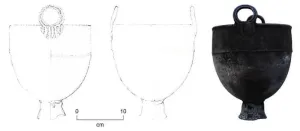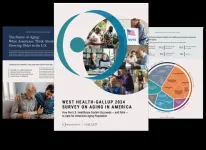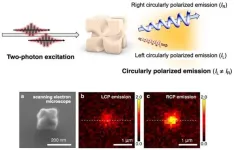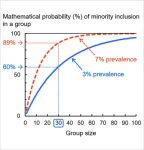Breaking down barriers: ROCK2 inhibition facilitates drug delivery in fibrotic pancreatic cancer
Researchers develop a human pancreatic cancer fibrotic barrier 3D model to mimic human conditions for assessing treatment strategies in pancreatic cancer
2024-06-05
(Press-News.org)
Pancreatic cancer, recognized as one of the deadliest cancers, poses a persistent challenge for medical professionals globally due to its aggressive behavior and resistance to conventional therapies. The dense fibrotic tissue surrounding pancreatic tumors acts as a significant barrier, hindering the delivery of macromolecular drugs such as antibodies and nanomedicines. Therefore, addressing fibrosis is crucial in enhancing therapeutic outcomes for patients with pancreatic cancer, whose prognosis remains bleak.
Understanding the underlying mechanisms driving fibrosis is essential in advancing treatment strategies for this devastating illness. The conventional models used for studying pancreatic ductal adenocarcinoma (PDAC) fibrotic environment often fail to accurately mimic the complexity of the disease. Seeking a more clinically relevant approach, a team of researchers led by Professor Mitsunobu R. Kano from Okayama University, Japan in collaboration with The University of Tokyo and Tohoku University developed a realistic human pancreatic cancer fibrotic barrier model using patient-derived pancreatic stellate cells (PSCs). Their research, co-authored by Prof. Hiroyoshi Y. Tanaka from Okayama University, Prof. Horacio Cabral from The University of Tokyo, and Prof. Atsushi Masamune from Tohoku University, was made available online on 29 March 2024 and was formally published in the May 2024 issue of the Journal of Controlled Release.
This innovative model offers a convenient, rapid, and highly reproducible experimental platform to assess pathogenetic mechanisms driving fibrosis as well as to test the efficacy of potential therapeutic interventions. Understanding the molecular mechanisms driving extracellular matrix (ECM) remodeling in PDAC fibrosis is crucial for overcoming treatment barriers. By dissecting these signaling pathways, researchers aimed to determine points of intervention that could be manipulated to enhance tissue permeability and develop more effective treatments for pancreatic cancer.
"We used advanced cell culture techniques along with molecular and pharmacological interventions to examine the signaling pathways involved in PDAC fibrosis," explained Professor Kano. "Initially, we assessed the impact of blocking the transforming growth factor-β (TGFβ) and Rho-associated kinase (ROCK) pathways on ECM remodeling and tissue permeability within our 3D fibrotic tissue model. Additionally, we also investigated the involvement of YAP (Yes-associated protein), a key regulator of cell differentiation, in mediating the effects of ROCK inhibition on ECM remodeling and tissue permeability."
The results shed light on promising avenues for enhancing drug delivery in PDAC by targeting specific signaling pathways involved in fibrosis. “Inhibition of the TGFβ pathway led to a reduction in ECM remodeling and improved tissue permeability of drugs in 3D-PDAC fibrotic model. Similarly, blocking the ROCK pathway, particularly through ROCK2 inhibition, resulted in decreased ECM remodeling and enhanced drug permeability. Knockdown experiments revealed the predominant role of ROCK2 in regulating these processes,” shares Prof. Kano. “Additionally, targeting the YAP protein, a downstream effector of ROCK signaling, produced similar improvements in ECM remodeling and drug permeability.” These findings highlight the potential of targeting the TGFβ/ROCK2/YAP signaling axis to mitigate fibrotic barriers and enhance drug delivery in pancreatic cancer, offering promising prospects for improving treatment outcomes in this challenging disease.
Looking ahead, the implications of the study extend beyond pancreatic cancer alone. “Fibrosis is prevalent not only in pancreatic cancer but also in other cancers that are difficult to treat, such as those affecting the stomach, breast, and lung, as well as in some non-cancerous diseases. With effective medical treatments lacking for fibrotic conditions, our findings offer a glimmer of hope for enhancing treatment strategies and outcomes in a broader spectrum of fibrotic cancers as well as non-cancerous fibrotic conditions,” concludes Prof. Kano.
About Okayama University, Japan
As one of the leading universities in Japan, Okayama University aims to create and establish a new paradigm for the sustainable development of the world. Okayama University offers a wide range of academic fields, which become the basis of the integrated graduate schools. This not only allows us to conduct the most advanced and up-to-date research, but also provides an enriching educational experience.
Website: https://www.okayama-u.ac.jp/index_e.html
About Professor Mitsunobu R. Kano from Okayama University, Japan
Mitsunobu R. Kano, MD, PhD, is a distinguished Professor of the Department of Pharmaceutical Biomedicine at Okayama University. Graduating from the University of Tokyo medical school, he brings over 20 years of experience and an impressive record of 70+ published articles cited 8500+ times to his esteemed position. His research primarily focuses on the integration of medicine and nanotechnology to combat drug-resistant cancers. Additionally, he has authored books on scientific thinking for the general public. Prof. Kano is also recognized for his pivotal role as the founder of the Young Academy of Japan and as various governmental roles including the first Science and Technology Co-Advisor to the Minister of Foreign Affairs of Japan.
END
[Attachments] See images for this press release:
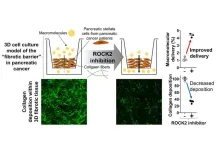
ELSE PRESS RELEASES FROM THIS DATE:
2024-06-05
DARIEN, IL – A new study to be presented at the SLEEP 2024 annual meeting found that circadian misalignment, which is highly prevalent in adolescents, is linked with carbohydrate consumption and sedentary behavior in teens.
Results show that a later sleep schedule was significantly associated with greater intake of carbohydrates, and this relationship was partially explained by irregular sleep timing. A later sleep schedule also was associated with greater sedentary behavior, even after adjusting for variables such as demographics, sleep disorders, and insufficient sleep.
“Delaying sleep schedules is normal during puberty and adolescence; however, some ...
2024-06-05
DARIEN, IL – A new study to be presented at the SLEEP 2024 annual meeting found that it is common for foster caregivers to give melatonin to their child, and these children who have taken melatonin have worse sleep and more daytime behavioral problems.
Results show that 48% of foster caregivers reported administering melatonin to their child. Children given melatonin had poorer overall sleep quality compared to children not given melatonin, yet even after adjustment for sleep quality and other potential confounders, melatonin use was associated with increased severity of daytime behavioral problems in foster ...
2024-06-05
Bronze cauldrons were used by the inhabitants of the Mongolian steppe around 2,700 years ago to process animal blood and milk. This is shown by a protein analysis of archaeological finds from this period.
Scattered across the Eurasian steppe, archaeologists repeatedly come across metal cauldrons from the Bronze Age during excavations. However, it was previously unclear exactly what they were used for. Now, an international study led by researchers at the University of Basel and published in the journal Scientific Reports reveals their secret: Mongolian nomads collected blood ...
2024-06-05
Scientists have discovered genetic clues to the cause of restless leg syndrome, a condition common among older adults. The discovery could help identify those individuals at greatest risk of the condition and point to potential ways to treat it.
Restless leg syndrome can cause an unpleasant crawling sensation in the legs and an overwhelming urge to move them. Some people experience the symptoms only occasionally, while others get symptoms every day. Symptoms are usually worse in the evening or at night-time and can severely impair sleep.
Despite the condition ...
2024-06-05
Scientists have detected what they believe to be a neutron star spinning at an unprecedentedly slow rate —slower than any of the more than 3,000 radio emitting neutron stars measured to date.
Neutron stars - the ultra-dense remains of a dead star - typically rotate at mind-bendingly fast speeds, taking just seconds or even a fraction of a second to fully spin on their axis.
However, the neutron star, newly discovered by an international team of astronomers, defies this rule, emitting radio signals on a comparatively ...
2024-06-05
Even widespread species could be genomically vulnerable to the climate crisis, scientists warn. By studying the DNA of puddle frogs living in central African rainforests, the scientists found that areas of high environmental variation foster high genetic variation. If these varied habitats and the frogs that live there are lost, genetic variants that could have allowed the species to evolve to survive the climate crisis could be lost too. Meanwhile, populations with low genetic variation could become extinct quickly, unable to adapt.
“Generally, the more genomic variation within ...
2024-06-05
WASHINGTON, D.C. — June 5, 2024 — Concerns over the potential insolvency of Medicare among those under 65 have risen, with 73% now expressing worry that it won’t be available when they need it, up from 67% in 2022, according to the new West Health-Gallup 2024 Survey on Aging in America. Worry rose most amongst those aged 50 to 64, up 13 percentage points to 74%. Higher percentages of adult’s express concern about the future of Social Security, with 80% of people under 62 and 86% of people aged 40 to 49 fearing it will not be around once they are eligible.
According ...
2024-06-05
doi.org/10.1002/adom.202400699When chiral(1) gold nanoparticles(2) are irradiated with near-infrared(3) femtosecond pulses(4), visible emission of luminescence is observed. In this study, this luminescence was found to yield high selectivity for left- or right-handed circularly polarized(5) light, depending on the chirality of the nanoparticles, with a dissymmetry factor(6) of approximately 0.7. This finding suggests the potential to elevate various applications using circularly polarized light to practical levels.
Abstruct
The research group led by Project Assistant Professor Dr. Hyo-Yong AHN, ...
2024-06-05
More than 3.4 million people in the US and 65 million people worldwide have epilepsy, a neurological disorder that affects the nervous system and causes seizures. One in 26 people will develop epilepsy at some point in their lives, and 1 out of 1000 people with epilepsy die from unexpected deaths each year.
Like many conditions, epilepsy treatment starts with early detection. The World Health Organization estimates that 70% of people with epilepsy could live seizure-free if adequately diagnosed and treated.
Over the years, ...
2024-06-05
Niigata, Japan - Human society includes various minority groups. However, it is often difficult to know whether someone is a minority member simply by looking at the person, as minority traits may not be visually apparent (e.g., sexual orientation, color vision deficiency). In addition, minorities may hide their minority traits or identities. Consequently, we may have been unaware of the presence of minorities in daily life. Probabilistic thinking is critical in such uncertain situations. The people with whom we interact in our daily lives are typically a group of several dozen individuals (e.g., a school class). How do we judge the probability of including at least one minority ...
LAST 30 PRESS RELEASES:
[Press-News.org] Breaking down barriers: ROCK2 inhibition facilitates drug delivery in fibrotic pancreatic cancer
Researchers develop a human pancreatic cancer fibrotic barrier 3D model to mimic human conditions for assessing treatment strategies in pancreatic cancer

